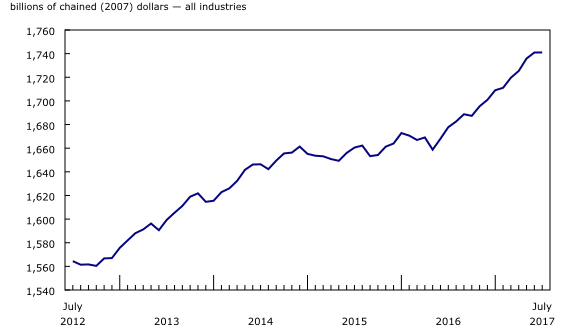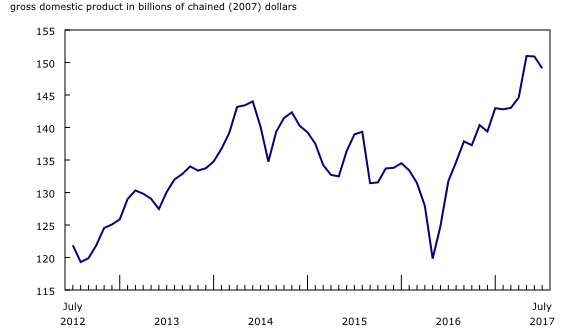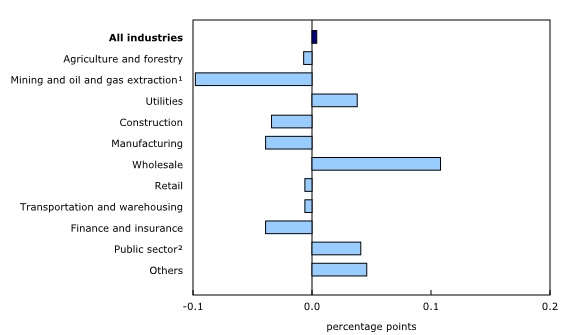Gross domestic product by industry, July 2017
Archived Content
Information identified as archived is provided for reference, research or recordkeeping purposes. It is not subject to the Government of Canada Web Standards and has not been altered or updated since it was archived. Please "contact us" to request a format other than those available.
Released: 2017-09-29
July 2017
0.0% 
(monthly change)
After rising for eight consecutive months, real gross domestic product (GDP) was essentially unchanged in July as 11 of 20 industrial sectors grew.
Goods-producing industries contracted 0.5%, the first decrease in five months, largely as a result of declines in mining, quarrying and oil and gas extraction and in manufacturing. Services-producing industries increased 0.2%.
The mining, quarrying, and oil and gas extraction sector contracts
The mining, quarrying, and oil and gas extraction sector contracted 1.2% in July, mainly due to a 1.8% decline in the oil and gas extraction subsector.
Non-conventional oil extraction was down for the fourth time in five months, decreasing 3.0%. Conventional oil and gas extraction decreased for the first time in five months, declining 0.8% as a result of lower crude petroleum extraction.
Mining excluding oil and gas extraction rose 0.9%. Metal ore mining rose 3.4%, led by strength in copper, nickel, lead and zinc mining (+4.5%) and iron ore mining (+7.1%), while gold and silver ore mining decreased 2.2%. Coal mining was up 1.0%. Non-metallic mineral mining declined 2.7% as lower output from potash mines (-12.6%) more than offset an increase in other non-metallic mineral mining.
Support activities for mining, oil and gas extraction declined 1.2%, down for the third consecutive month, due to declines in support activities for oil and gas extraction on lower drilling services.
Wholesale trade grows
Wholesale trade activity rose 2.0% in July, the highest monthly gain since September 2014. Growth was broadly-based across the sector as seven of nine subsectors were up. Leading the growth was a 5.3% increase in building material and supplies wholesaling. Machinery, equipment and supplies wholesalers recorded a 2.3% increase on the strength of increased activity across most industry groups. Motor vehicle and parts wholesaling rose 1.9% on the strength of stronger sales of motor vehicles.
The manufacturing sector declines
The manufacturing sector was down 0.4% in July. This sector has generally been posting increased activity since the second half of 2016.
Durable manufacturing declined 0.9%, following four consecutive months of growth. The largest contributor to the decline was a 5.6% decrease in the transportation equipment manufacturing subsector. Motor vehicle manufacturing was down 13.5%, in part as a result of changes in vehicle models being produced in Canada. Motor vehicle parts manufacturing was down 7.1% while miscellaneous transportation equipment decreased 1.0%. In other durable manufacturing subsectors, machinery manufacturing dropped 3.6% while non-metallic mineral product and miscellaneous manufacturing increased.
Non-durable manufacturing was up 0.3% in July after being essentially unchanged in June. Increases in plastic and rubber products (+2.0%) and chemical products manufacturing (+1.3%) more than offset declines in food (-0.7%) and petroleum and coal products manufacturing (-0.7%).
Finance and insurance declines
The finance and insurance sector declined 0.6% in July, its largest decline since April 2015. Depository credit intermediation and monetary authorities declined 1.0% on decreased activity at banking, monetary authorities and other depository credit intermediaries. Financial investment services, funds and other financial vehicles were down 0.8%, with the timing of Canada Day and of the United States' Independence Day having an effect on the level of market activity. Insurance carriers and related activities rose 0.3%.
Construction declines
The construction sector declined 0.5% in July, after posting one of its largest gains in the last four years in June following work stoppages in Quebec in May. Residential construction was down 0.9% as new construction of double and row houses declined, along with housing alterations and improvements. Non-residential construction grew 0.6% as industrial and commercial constructions were up while public construction edged down. Repair construction was down 1.3% while engineering and other construction was essentially unchanged.
Transportation and warehousing edges down
Transportation and warehousing edged down 0.1% with five of nine subsectors showing decreases. Pipeline transportation was down 1.9%, partly due to wildfires in British Columbia forcing the temporary closure of some pipelines, as movement of natural gas (-3.2%) and crude oil (-0.7%) by pipeline declined. Rail transportation was down 1.2% as movement by rail of coal, automotive products, grains and fertilizers and industrial products declined. Support activities for transportation was down 0.8%. Partly offsetting the declines was growth in air transportation (+2.2%), warehousing and storage (+1.4%) and transit, ground passenger, scenic and sightseeing transportation (+0.6%).
Retail trade edges down
The retail trade sector edged down 0.1% as its 12 subsectors were evenly split between increases and decreases. The largest declines in terms of activity were at gasoline stations (-3.0%) and electronics and appliance stores (-4.9%). These were partly offset by growth at food and beverage stores (+0.8%) and health and personal care stores (+0.4%).
The utilities sector grows
The utilities sector was up 1.7% in July. Higher demand for electricity in Western Canada, in order to cope with a hot and dry July, led to a 2.3% gain in electric power generation, transmission and distribution. Natural gas distribution was down 0.9% from lower residential demand.
Real estate and rental and leasing grows
Real estate and rental and leasing edged up 0.1% in July following two consecutive months of decline.
For the fourth month in a row, activity at the offices of real estate agents and brokers contracted, down 1.5%. Housing resale activity decreased in most markets, led by continued declines in and around the Greater Toronto Area.
Other industries
The public sector (education, health care and public administration) rose 0.2% as all three components increased.
Professional services rose 0.5% on the strength of increases in legal, accounting and related services (+1.2%), computer systems and related services (+0.5%) and architectural, engineering and related services (+0.6%).
Accommodation and food services rose 0.4% as activity at food services and drinking places was up 0.5%, while accommodation services increased 0.3%.
Agriculture, forestry, fishing and hunting was down for the ninth time in ten months.

In celebration of the country's 150th birthday, Statistics Canada is presenting snapshots from our rich statistical history.
Today we look at the year 1967, which marked the celebration of the centenary of the Canadian Confederation and the World Expo (Expo 67). These two national and global events influenced tourism industries in Canada and had an impact on real gross domestic product (GDP) in 1967.
Various artistic, cultural and sporting events took place throughout the country in 1967, including the lighting of the centennial flame in Ottawa on January 1, 1967, the Pan-American Games held in Winnipeg from July 23 to August 6, and the Centennial train that crisscrossed the country attracting more than 2.5 million visitors. The World Expo (Expo 67) was held in Montréal from April 28 to October 29, attracting more than 50 million visitors.
All of these events had an impact on real GDP during the second and third quarters of 1967. The entertainment and recreation sectors rose by 10% in the second quarter of that year. The air, transit, passenger rail and bus transportation and accommodation sectors also recorded increases in the second and third quarters of 1967, due to the influx of tourists who were drawn to these events.
Sustainable Development Goals
On January 1, 2016, the world officially began implementation of the 2030 Agenda for Sustainable Development—the United Nations' transformative plan of action that addresses urgent global challenges over the next 15 years. The plan is based on 17 specific sustainable development goals.
Gross domestic product by industry is an example of how Statistics Canada supports the reporting on the Global Goals for Sustainable Development. This release will be used in helping to measure the following goal:

Note to readers
Monthly gross domestic product (GDP) by industry data at basic prices are chained volume estimates with 2007 as the reference year. This means that data for each industry and each aggregate are obtained from a chained volume index, multiplied by the industry's value added in 2007. Monthly data are benchmarked to annually chained Fisher volume indexes of GDP obtained from the constant-price supply and use tables (SUT) up to the latest SUT year (2013).
For the period starting with January 2014, data are derived by chaining a fixed-weight Laspeyres volume index to the prior period. The fixed weights are 2013 industry prices.
This approach makes the monthly GDP by industry data more comparable with expenditure-based GDP data, which are chained quarterly.
All data in this release are seasonally adjusted. For information on seasonal adjustment, see Seasonally adjusted data – Frequently asked questions.
For more information on GDP, see the video What is Gross Domestic Product (GDP)?
Revisions
With this release of monthly GDP by industry, revisions have been made back to January 2016.
Each month, newly available administrative and survey data from various industries in the economy are integrated and result in statistical revisions. Updated and revised administrative data (including taxation statistics), new information provided by respondents to industry surveys, and standard changes to seasonal adjustment calculations are incorporated with each release.
Real-time CANSIM tables
Real-time CANSIM table 379-8031 will be updated on October 16. For more information, consult the document Real-time CANSIM tables.
Next release
Data on GDP by industry for August will be released on October 31.
Products
For more information about monthly national GDP by industry, see the System of Macroeconomic Accounts module on our website.
The User Guide: Canadian System of Macroeconomic Accounts (13-606-G) is also available.
The Methodological Guide: Canadian System of Macroeconomic Accounts (13-607-X) is also available.
Contact information
For more information, contact us (toll-free 1-800-263-1136; 514-283-8300; STATCAN.infostats-infostats.STATCAN@canada.ca).
To enquire about the concepts, methods or data quality of this release, contact Craig Kavanagh (613-618-2451), Industry Accounts Division.
- Date modified:




